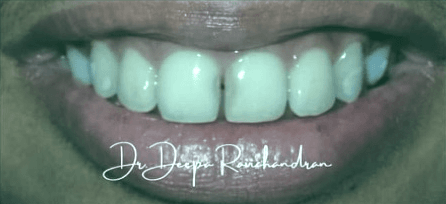Minimally Invasive Dentistry – Is It a One-Stop Solution?
There seems to be a popular trend in dentistry these days – minimally invasive dentistry (MID)! This encompasses composite restorations, porcelain laminate veneers, no prep additive dentistry. There was a paradigm shift in how we viewed our cases – instead of crowns everywhere, we started becoming more conservative in our treatment plans. Now, along with this, there started another trend, which is a little disturbing – brutal criticism of anybody who decides on a treatment plan involving crowns! Frankly…I am a little stunned, because while I appreciate the trend towards MID , it is not necesarrily a one-stop solution for all cases!
The issue with minimally invasive dentistry is, its additive and in most cases, there is no consideration of functional occlusion. Yes, anterior teeth do play a very important role in functional occlusion, apart from speech and esthetics. Its not only the posterior occlusion that counts! Anterior teeth play an important role in mutually protected occlusion (MPO), which is, only the anterior teeth contact in protrusive movement, disoccluding the posteriors and in lateral movements, there is contact only between the upper and lower canine with disocclusion of the posteriors. This is very important as this is how the anteriors protect the posteriors in excursive movements, and the posteriors return the favour in maximum intercuspation position (MIP).
Occlusion in Esthetic Cases? Yes, Always!
Whenever we decide to do any esthetic dentistry, we must first evaluate the existing functional occlusion. In most cases, corrections are required, and we are obligated to do it for our patients, for esthetics without function has no value. When we offer our patients minimally invasive dentistry, are we really communicating our treatment plan in the right way? For e.g. if we haven’t evaluated the functional occlusion, are our patients making a conscious decision in accepting the smile makeover we are offering them (through minimally invasive dentistry) that has no functional value?
When we start looking at our esthetic cases through the lens of functional occlusion, we realize that not all cases qualify for minimally invasive dentistry! When we do veneers, we add to the existing labial surface of anterior teeth, and by doing so, we straighten out the teeth which are mismatched in alignment, form etc. But what about the arch form of such teeth? Without touching the palatal surface, the arch form cannot be changed, and without changing the arch form, we cannot achieve functional occlusion in anterior teeth. Arch form matters! Not to mention, the added bulk on the incisal edge may not be comfortable to all patients and affect MPO.
The justification for minimally invasive dentistry is “its conservative”. While I don’t disagree with that, I think the word conservative is often misused, especially in the context of composites versus crowns. Rather than using the term “conservative” to align with minimally invasive dentistry and the term “radical” for any treatment plan that involves a tooth prep, what we need to do is, make a list of all the treatments that a patient requires with respect to functional occlusion. Once we do that, it may become apparent that most of it cannot be achieved with MID, and that’s when we start looking at other options to treat the case – either with orthodontics or prosthetics. Finally, we must choose the option that can correct maximum with minimum intervention – and that should be the true meaning of conservative dentistry.
Yes, orthodontics is conservative, but not every patient can commit to the time and budget needed for it, and we must respect that. Plus in many cases, the patient has prior h/o of orthodontic treatment, which has not gone right, and they are not interested in embarking on that journey again. That ship has sailed for them, BUT we owe it to our patients to give them good functional occlusion, if not orthodontically, then prosthetically. Below is a case in point of a 20yr old young lady, who wanted – smile correction, diastema closure & caries restoration, after orthodontic treatment.
Case Report







While this article shows selected excerpts, the case in its entirety can be found on Dental Reach. Please click here to view the entire case and leave your thoughts in the comment section.
I would like to conclude by saying that, while its good to embrace new trends, especially those on social media, it must be tempered with a thorough understanding of functional occlusion. We as clinicians owe it to our colleagues to temper our criticism of their treatment plans, with the same!




















Good one!
Thank you! ☺